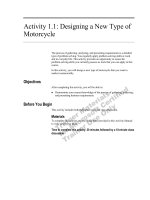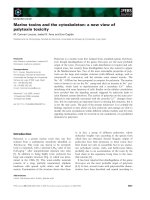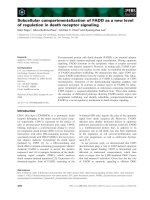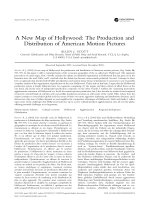What is communication ? How does a communication process happen? Design a communication strategy to launch a new product of Company Nike
Bạn đang xem bản rút gọn của tài liệu. Xem và tải ngay bản đầy đủ của tài liệu tại đây (301.23 KB, 12 trang )
Họ và tên : Đoàn Bá Thanh Tùng
Mã Sinh viên: 19LK73402010058
Lớp : K104
Niên Chế : K10
STT : 07
ID Phòng thi :
Ngày thi : 7/10/2021
Giờ thi : 14h10
BÀI THI MÔN : SOCIAL COMMUNICATION
Hình thức thi : Tiểu Luận
Thời gian thi : 24h
What is communication ? How does a communication process happen?
Design a communication strategy to launch a new product of Company
X. Company X is your own choice.
1
ACADEMY OF FINANCE
FINAL EXAM
INTERNATIONAL TRAINING PROGRAM
Subject: Social Communication
BANKING- INSURANCE
Class : K104
Duration: 24h
Open book
Question 1. What is communication ? How does a communication process happen ? Design a
communication strategy to launch a new product of Company X. Company X is your own choice.
1. What is communication ?
Communication is a process in which people exchange information to understand each other and
respond to suit a particular situation.
2. How does a communication process happen ?
Communication occurs when a sender expresses an emotion or a feeling, creates an idea, or
senses the need to communicate. The communication process is triggered when the sender
makes a conscious or an unconscious decision to share the message with another person—
the receiver.
Communication can be thought of as a process or flow. Communication problems occur when
deviations or blockages disrupt that flow. Before communication can take place, a purpose,
expressed as a message to be conveyed, is needed. It passes between a source (the sender) and a
receiver. The message is encoded (converted to symbolic form) and is passed by way of some
medium (channel) to the receiver, who retranslates (decodes) the message initiated by the sender.
The result is communication, which is a transfer of understanding and meaning from one person
to another depicts the communication process. This model has seven parts: (1) the communication
source or sender, (2) encoding, (3) the message, (4) the channel, (5) decoding, (6) the receiver,
and (7) respond.
3. Design a communication strategy to launch a new product of Nike Inc.
I.
Introduction.
3.1.Introduction:
Nike, Inc. is an American multinational corporation engaged in the design, development,
manufacturing, marketing and sales of footwear, clothing, accessories, equipment and related
services. sport. The company's headquarters are located near Beaverton, Oregon, in the
Portland metropolitan area. Nike is the largest supplier of sports shoes and clothing in the
2
world and also a well-known manufacturer of sports equipment, with a profit in 2018 of $
36.39 billion. In 2018, the group also had about 73,100 employees worldwide. The group's
brand was also valued at $29.6 billion in 2017, making it the most valuable brand in the
sporting goods business. Nike ranks 89th on the 2018 Fortune 500 list of the largest US
corporations by total revenue.
II.
III.
Theoretical framework
Communication takes place whilst a sender expresses an emotion or a feeling,
creates an idea, or senses the want to communicate. The communique procedure
is precipitated whilst the sender makes a aware or an subconscious choice to
percentage the message with any other man or woman—the receiver.
Communication may be notion of as a procedure or flow. Communication
troubles arise whilst deviations or blockages disrupt that flow. Before
communique can take place, a purpose, expressed as a message to be conveyed, is
needed. It passes among a supply (the sender) and a receiver. The message is
encoded (transformed to symbolic form) and is surpassed via way of means of
manner of a few medium (channel) to the receiver, who retranslates (decodes) the
message initiated via way of means of the sender. The end result is communique,
that is a switch of knowledge and which means from one man or woman to any
other depicts the communique procedure.
Situation Analysis:
i. PEST Analysis For Nike, Inc.
Political Factors
• Favorable US Government Policies:
The government policies always have a profound impact on the businesses especially which are engaged
globally. The US government has always initiated growth-oriented policies which have helped the
company to grow and expand internationally. The trade regulations, stable government and international
competitive tax arrangements by the Federal Reserve fosters its growth (Whitehead, 2012). As Nike, Inc.
is known for its environmental-friendly business strategies, it receives considerable tax benefits in this
regard.
• Political Unrest in Some Asian countries
Most of the factories of Nike, Inc. are located in the emerging Asian countries like Thailand, Vietnam and
Indonesia. The political unrest in Thailand in the last few years was a major concern for the management
of Nike, Inc. where more than 35 factories are located. The situation was equally gloomy in Vietnam,
Indonesia and parts of China in stages as any form of protest, political instability or social unrest can
disturb the supply chain of Nike, Inc.
• Changes in International Law
3
The international law in the last one decade has become more stringent with the rising threat of terrorism.
Various countries have imposed new rules and regulations to counter the growing threat of illegal
activities within their territory. The increase in tariffs in some countries while the strict rules of
immigration and visa are one of the important concerns for every global firm and Nike, Inc. is not an
exception. United States, where the headquarters of Nike, Inc. is located is always under constant threat of
terrorist attacks which pose a potential threat for the normal functioning of Nike, Inc.
Some of the countries also impose various tariffs to protect their indigenous brands for which Nike, Inc. is
a serious threat. This trade protection hinders the growth of Nike, Inc. in those respective nations.
Economic Factors
• Rise in Production Cost and Labor Issues
One of the main reasons for Nike, Inc. to set up their base in Asian countries is the low labor cost. But
with the economic boom and rise in living standards, the production cost in these countries has raised
manifolds (Scmp.com, 2014). The labor issues are quite common in the factories of Nike, Inc. recently. In
April 2014, Nike, Inc. experienced the biggest strike as most of the factories in China stopped production
citing low wages. It had a significant effect on the production as well as the revenue of the company.
Nike saw a comeback of a similar protest in July 2017 where a number of claims were made. Among all
the claims, the most prominent ones are that workers at a Nike contract factory in Hansae, Vietnam,
suffered wage theft and verbal abuse, and labored for hours in temperatures well over the legal limit of 90
degrees, to the point that they would collapse at their sewing machines. Nike is also accused of cutting
jobs at the Hansae factory and pulling production from a factory in Honduras with a strong union
presence, resulting in hundreds of workers losing vital jobs. Such claims and protests are quite
detrimental for the company’s growth. (Source: /qz.com/)
• The Threat of Recession and Competition
Nike, Inc. needs to devise a plan how it can tackle another global economic recession. Being a market
leader, Nike, Inc. can be affected significantly as it experienced in the last decade (2008-09). Last time, it
was noticed that during the recession that consumers replace Nike with some other brand which offers the
same products at a lower price. So, the threat of recession always has a paired effect on Nike, Inc.
• Fluctuating Profit Margin
Nike performs all its business on the global spectrum. Hence, the stability of currency exchange and
international interest rates in crucial to consistent growth of its profit margins (Nytimes.com, 2009).
However, the higher inflation rate at the domestic level (USA) with the fluctuating currency rates with
respect to the Dollar always has detrimental effects on the annual profit margin. According to Forbes,
gross profit margin for Nike’s apparel division declined by 2.4% in 2011 and the primary reason being the
volatile economic condition around the world (though the input costs also rose during this period).
• Acquisitions and Subsidiaries
Nike, Inc. has acquired various companies which function within its domain of footwear and apparel
industry. It started in the year 1988 when it acquired Cole Haan (New York times). Since then, it has
purchased many companies to strengthen their base in the world. Nike owns Brand Jordan, Converse,
4
Hurley, and SPARQ. However, some of these acquisitions put a major pressure on their finances without
any significant accomplishments.
Social Factors
• Consumers Becoming More Brand Conscious
Globally most of the consumers have became brand conscious. They associate Nike, Inc. with quality and
stature. This increase in brand awareness has helped the business of Nike, Inc. to grow. They were the
first company that introduced innovation in the footwear and apparel industry. The amalgamation of style
with technology led the foundation of success for Nike, Inc. which continues till today (Scribd.com,
2016). Apart from the products, the Swoosh logo and their slogan ‘Just do it!’ is highly popular and
recognized around the world.
• Consumers Becoming Health and Fashion Conscious
Every year the number of people visiting the nearest gym to maintain their health, body and physique is
increasing exponentially. Indirectly, this rise helped Nike, Inc. to boost up the sales as they turn to buy
footwear and apparel for themselves to look athletic. Some of the consumers also associate Nike, Inc.
with fashion and leisure (About.nike.com, 2016). They too are getting interested to buy Nike, Inc.
products. This awareness among the people would help Nike, Inc. in the long run.
• Increase in Female Consumers
Nike, Inc. has devised the key strategy to grow their business in the next few years by targeting the
increasing number of female customers. Nike has announced a new approach in designing and selling
shoes to the growing number of female sneaker fans out there. It includes expanded, unisex sizing on
some of its classic Jordan styles and hyped designer collaborations, a push for more partnerships with
female creatives, and Nike Unlaced—a retail concept aimed squarely at women.
• Working Conditions at Factories
Nike, Inc. is often accused of its hazardous working conditions in its factories especially in the Asian
countries. It has been alleged that it is using sweatshops to produce footwear and apparel since the 1970s.
Initial denials from the authorities and Nike, Inc. itself made the situation even more complicated which
affected its image globally. During the 1990s, Nike, Inc. installed the code of conduct for their factories
with defined regulations for safety, security, optimum wages and overtime limits (Businessinsider.com,
2015). Since then, the working environment improved in the factories. Consumers always want their
company to be socially responsible.
Technological Factors
• Innovation
Nike, Inc. is often referred as the Apple Inc. of apparel and footwear. It is regarded as the pioneer to
introduce various products which enthralled the whole world. It has always adapted the latest technology
to ameliorate their products. This technological innovation not only helped them to set ahead from their
competitors but also refined and augmented the production process (About.nike.com, 2016). It is also one
5
of the global brands which took a revolutionary step to curb the usage of chemicals and other raw
materials which are detrimental for the environment. The latest popular product introduced by Nike, Inc.
Is Tech Pack Fall 2018 apparel, which received acknowledgment globally
• Marketing Techniques
With the global rise in sales and impact, Nike, Inc. has also altered their marketing strategies to
reach their customers and prospective consumers. The increase in advertising concentrating on
the digital medium more than the traditional channels is one such step. Nike, Inc. uses online
media and apps to reach the customers and popularize their different products. In the last few
years, the market of online shopping has expanded which has given Nike, Inc. the opportunity to
increase their base worldwide. Now, Nike, Inc. does not have to depend on their stores and
franchises outlets to sell their popular footwear and apparel. For the year 2015, Nike, Inc.
reported a 55% increase in sales through web. The figures touched $1.19 billion crossing the
billion mark for the first time through the internet sales. According to the reports, Nike’s revenue
in 2017 in Greater China (Nike's third-largest market after North America and Europe, the
Middle East and Africa) continued to be a bright spot on the company’s earnings report, growing
16% in the quarter and totaling $1.2 billion. Nike's divisional revenues in Europe, the Middle
East & Africa grew by 19% to $2.1 billion.
ii. SWOT Analysis For Nike, Inc.
STRENGTHS
• Product Innovation
In the competitive world, innovation is a crucial determinant of sustainability. Nike, Inc. has always been
successful and is regarded as one of the pioneers to introduce various enthralling products. With the
constantly evolving and innovative product range, it has solidified its position as one of the leading
brands in the apparel and footwear industry.
• Strong Global Brand
Nike, Inc. is regarded as one of the strongest global brands which have its prominent presence all over the
world. The brand is promoted by the leading celebrities and sports professionals which creates significant
brand equity in terms of recognition and image (Businesstoday.in, 2016). It is also the brand ambassador
of various sporting events and teams (at domestic and national level). Some of the legendary sportsperson
(or teams) who promoted or still promote Nike, Inc. are Michael Jordon, Cristiano Ronaldo, Rory Mcllory
and Rafael Nadal. These influential endorsements along with the captivating slogan ‘Just do it’ is
recognizable and inspire all its potential consumers.
• Low Cost Manufacturing with Strong Cash Flow
Nike, Inc. has always followed an effective marketing strategy which helps it to reduce the cost of
manufacturing. Most of their factories and production units are located in Asian countries which are
6
emerging economies as well as involve low production cost. Their plants are located in China, Vietnam,
South Korea and Thailand. Apart from these units, it also has manufacturing firms located in South
American countries and in USA (Seattlepi.com, 2016).
WEAKNESSES
• Excessive Dependence on Footwear
Nike, Inc. has a diversified range of products which includes apparels, equipment and footwear. But the
marketing trends exhibit that the sustainability of Nike, Inc. is dependent on the sales of its footwear
(Statista.com, 2016). If in any circumstances, the footwear segment experience an erosion then the whole
organization would be affected adversely. In North America itself, more than half of the revenue gets
generated from the footwear every year.
• High Prices of its Products
As Nike, Inc. enjoys huge reputation throughout the world, almost all the products are premium ranged.
Through it supports their strategy of higher margins of profitability but it significantly reduces the number
of prospective customers especially in the emerging economies of Asia and South America. The high
prices of their products also encourage the competitors of Nike, Inc. to keep their charges low giving
them an opportunity to increase their market share. As the company is expected to continue with their
price hiking strategy (Marketrealist.com, 2016), it will probably result in the loss of key market share in
Japan and Brazil. But it will continue to reign in other global segments.
OPPORTUNITIES :
• Explore Emerging Markets
In the 21st century, countries like China, India, Brazil, and South Africa exhibited high economic growth
when European and American economies slowed down. Consumers in these countries had high
disposable income with increasing interest in western brands (Forbes.com, 2016). These countries can
turn into significant markets for Nike, Inc. Exploring these markets can boost up the sales of Nike, Inc. by
manifolds and hence increase the profit margins. Though Nike, Inc. has already stepped into these
countries, still the potentialities have not been exploited completely. The main strategy that Nike, Inc.
undertook to popularize their products in these countries is to endorse the popular sports.
• The Rise of e-Commerce Trade
Till the last decade, Nike, Inc. had to reach the customers through their own retailer stores or their
franchises. But the rise in the e-commerce sector now allows every customer to book their selected
product from their smartphone and get it delivered at their home anytime. The marketing strategists
projects that by 2020, e-commerce sales will be responsible for one-third of overall growth
(Internetretailer.com, 2016). They also project that the total sales in the fiscal 2020 will reach $7 billion.
7
THREATS
• Intense Competition
Nike, Inc. functions in such an industry that is highly competitive. Nike, Inc. enjoys a better position in
terms of market share when compared with competitors. But it faces stiff completion from Adidas, Puma
and other reputed brands. All these brands produce the similar athletic footwear, apparel and other
equipment which makes the competition much more intense (Statista.com, 2016). While the industry is
highly competitive, the customers always have the option to substitute a product with a similar one of
other company if they are not satisfied with the quality or service.
•
•
•
•
•
•
•
•
b. Communication Objectives
i. Goal Classification
Budget: 5 billion VND
Time Limit: 6 months
Long- term goal : global brand coveraged with 60% of users compared to total
reach
Short- term goal : Through marketing strategies, reaching niche audiences such as
children under the age of 13 or the elderly with specific requirements.
Specifically, about 800,000 target customers
Process goal : organize fun events for children, cooperate with kindergartens,
primary schools, nursing homes, apartment buildings to introduce products.
iii.
Identifying the target audiences
Which behavior does the organization use to define its target audience?
- Determine the age of the customer : under 13 and over 50
- Determine where the customer lives : kindergarten, schools, apartments,
- Determine their hobbies : under 13: colorful, impressive; over 55: cheap but
fancy and endure
- People who have influence over them : under 13: their parents.
What demographics does the target audience have in common
Nike is a brand that specializes in fashion and trendy products, so their target
audience will be between the ages of 18-24, also known as the Gen Z generation
What are the characteristics and lifestyles of these subjects?
- Like beauty, shopping for fashion
- Hunting for sale, buy products with reasonable price but quality
- Following the trend of singers, beauty bloggers..
What media is the audience using (or being influenced by)??
Not only the target customer, everyone's main means of communication
nowadays is social media
Is the audience participating or supporting an organization like yours?
8
•
•
•
Yes, because Nike has built a great brand and reputation in the hearts of
customers
Has the organization "touched" the right audience?
With the age from under 13 and over 50, it is not difficult to reach because this
customer file is quite new and if discovered, it will be very beneficial.
Which benefits does the organization bring to the target audience? Any
positive change??
At this age, it will be a bit difficult because the range of customers is not wide,
but for children under the age of 13, noisy activities are easy to leave deep
memories with them. In addition, the fact that parents are always with us will also
be an opportunity for us to reach other customers.
What needs, obstacles or difficulties does the target audience have?
- For this number of customers who are not economically independent but
dependent on the economy, it is difficult to bold the brand image so that they
have anxiety and desire to use the product.
iv.
•
•
Solutions
a. General
Influencer Marketing:
This is a method used by many big brands, because customers always trust the
products that their favorite stars are using, or even the statements from the stars.
With this tactic, Nike has partnered with many celebrities not only in the sports
field, but also actors, or Youtube-influencers who have great influence on the
online community.
Social Media Marketing:
Smooth coordination between different social media channels is not a simple
strategy. We must understand very well how it works on each channel, and the
usage behavior of customers through each channel, because they will never be the
same. Nike has used these social networking sites as much as possible to interact
directly with consumers, but besides that, it has also not forgotten to adjust the
way it works on each separate channel.
- Twitter: Nike has separate Twitter accounts for each of its sub-brands, and
for each of those channels, Nike focuses on responding to @mentions. Nike
will answer questions about products, merchandise information, and orders
with each individual customer. The consultation and customer care stages are
therefore done very carefully and thoughtfully.
- Instagram: Nike's Instagram is one of the most popular accounts, with a
respectable following of 79.5 million people. Using both video and artwork,
Nike showcases photos of its most popular products on its main and subaccounts. Nike especially uploads images of product users and beautiful
9
•
landscapes, taken in the most natural way to make customers feel closer to the
brand.
- Facebook : Nike has separate Facebook fan pages for each of its product
categories. Nike's sports pages regularly update images and videos every day,
often featuring company-sponsored athletes and Nike products.
- Youtube :Youtube is also a channel that Nike focuses on and promotes
promotional videos, or series that create interaction between customers and
brands.
Emotional Branding Strategies:
Nike's ads are always carefully invested, with deeply inspirational messages. In
particular, Nike often collaborates with world-class sports stars, providing an
impressive look at the outstanding skills of these idols. In the field of sports
fashion, it can be said that Nike is the brand with the best advertising measures.
b. About Budget
1. Marketing message "Just Do It".
2. Objectives of the strategy
- Promote Nike products nationwide, convey the message: Nike is all you need
- Drive target customers from awareness to memory and use of the product and
recommend it to others. Bring profits to the company.
3. Criteria of the campaign
- Advertising on social networks Tik Tok: Using TikToker's images affects young
people.
- Communication and PR: The message sent to the audience must highlight the
fashionable, durable, and low-cost features of the product. It infuses cloudy foam and
soft boost technology.
- Promotions: Discounts for players, sports athletes, etc and viewers of product
discount codes.
4. Strategy phase
1. Phase 3: Maintenance (after 3 months of product launch). Sponsor recurring
programs and promotions.
2. Phase 2: 3 months after product launch in densely populated places,
commercial areas, televisions. Additional items to support sales: product shelves,
screens, hangers for PR advertising, Activation, promotion.
3. Stage 1: Before product launch Completing the brand identity system, sales
support items. Publish articles about products through social networking sites.
5. Communication
- Triggers, magazine ads, bus ads, bus stops, posters at shopping malls.
10
- Advertise on the website (depending on the stage with appropriate advertising lines)
- Representative model: KOL Bui Tien Dung will participate in product promotion
events, post articles on his personal page with Nike product images on his personal
page.
6. Things to do
1. Sign a contract with KOL Bui Tien Dung to become a brand representative for
Nike
2. Bui Tien Dung will appear on the poster. publications, activities, events and
contests. - Advertising with the participatiosn of guest Bui Tien Dung:
b) Sign a contract with a media channel
Budget
1) Influencer cost
- Discount cost for KOL: 1,000,000,000 (For each product purchased through kols
promotion, discount: 10% of product value/1 product).
- KPIs for KOLs: >= 200 products/month, you will be rewarded with an
additional 5% on the total value of promoted products.
2) Hanging on the web
- Phase 1: 150,000,000 VND
- Phase 2: 70,000,000 VND
- PR: Production 10,000,000 VND
- Posted in 2 installments: 140,000,000 VND
3) Brand Ambassador
- Sign a contract with Bui Tien Dung for 3 years: 3,000,000,000 VND
- Additional cost: 1,500,000/1 post with product image Cost for companion
activities: 100,000,000 VND Total cost 3,97,000,000 + Additional cost =
4,548,000,000 VND
v.
Conclusion:
In summary, this is the marketing model for the fashion brand NIKE
with all costs calculated in the total capital allocated. I hope this will
be a marketing model that brings positive feedback from the market,
thereby further expanding the Nike brand in Vietnam in the hearts of
consumers.
11
TABLE OF CONTENT
I. Introduction……………………….. ….. 2
II.
Theoretical Framework…….. ...... 3
III. Situation Analysis…………………… 3
i. PEST Analysis for Nike……………3
ii. SWOT Analysis for Nike….............6
iii. Identifying target audiences……….8
IV. Solution
a. General ( Strategy and Tactical)………..9
Define timeframes and resources
b. About the Budget ……………………….10
c. Budget……………………………………10
12









